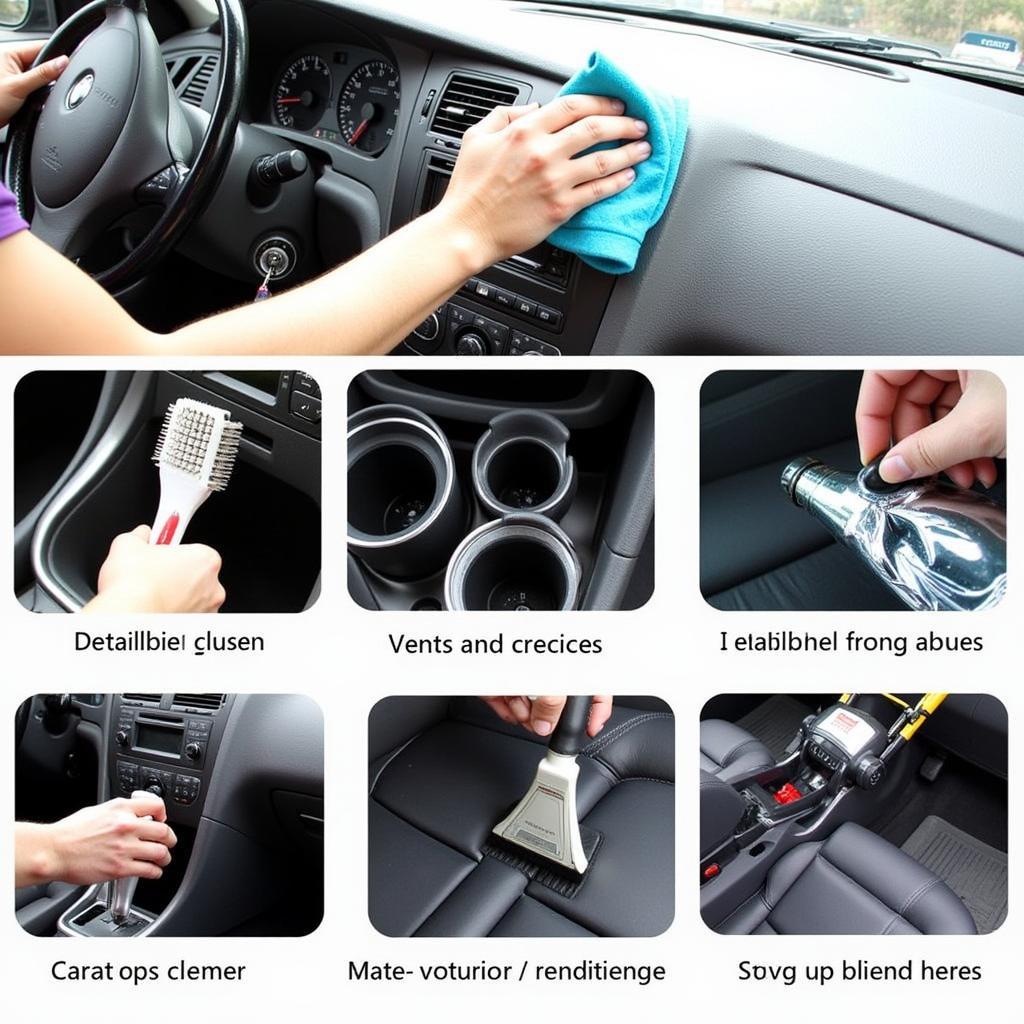Auto detailing is more than just a simple car wash; it’s a thorough cleaning, restoration, and finishing of your vehicle, inside and out. Learning How To Auto Detail Your Car not only enhances its appearance but also protects its value and extends its lifespan. This comprehensive guide will equip you with the knowledge and techniques to achieve professional-level results from the comfort of your own driveway.
Knowing how to prepare your car is the crucial first step in auto detailing. This involves gathering the necessary supplies and equipment and ensuring your vehicle is ready for the process. You might be surprised at how often people overlook this vital step! More on that later. See our guide on how to prepare your car for auto detailing.
Washing and Drying: The Foundation of Auto Detailing
The first step in how to auto detail your car is a thorough wash. This isn’t your average drive-through car wash; it’s a meticulous process using the two-bucket method. One bucket contains your soapy water, and the other is for rinsing your wash mitt. This prevents dirt and grime from being reapplied to your car, minimizing swirl marks. Use a pH-neutral car wash soap specifically designed for automotive paint. After washing, dry your car with a microfiber drying towel to prevent water spots.
The Importance of a Proper Wash
A proper wash is crucial for removing loose dirt and contaminants before moving on to more intensive cleaning stages. This prevents scratching during the polishing and waxing stages. Consider using a pressure washer for pre-rinsing to remove heavy dirt and debris.
Paint Correction: Restoring Your Car’s Shine
Paint correction involves removing imperfections like swirl marks, scratches, and oxidation. This step requires specialized tools and products like clay bars, polishing compounds, and dual-action polishers. While it can be more challenging for beginners, understanding the basics of paint correction can significantly improve your car’s appearance.
Assessing Your Car’s Paint Condition
Before starting paint correction, assess your car’s paint. Look for swirl marks under direct sunlight. Run your hand over the paint; if it feels rough, it likely has embedded contaminants. This helps determine the level of correction needed. If you are unsure about tackling paint correction yourself, consider visiting a professional detailer. Check out our review on A&U Auto Spa Hand Car Wash & Detailing Center for a professional opinion.
Interior Detailing: A Pristine Cabin
Interior detailing involves deep cleaning and conditioning all surfaces within the car. This includes vacuuming, shampooing carpets and upholstery, cleaning leather, and protecting vinyl and plastic trim.
Don’t Forget the Details
Pay attention to often-overlooked areas like air vents, door jambs, and seat crevices. Use specialized detailing brushes to reach these tight spots. A clean interior not only enhances the overall driving experience but also helps maintain the car’s resale value. Want to learn about the benefits of getting your car detailed? We’ve got you covered.
 Interior Car Detailing Process
Interior Car Detailing Process
Protecting Your Investment: Waxing and Sealants
After washing, drying, and correcting your car’s paint, it’s essential to protect it with a wax or sealant. Wax provides a deep gloss and enhances the paint’s color, while sealants offer longer-lasting protection.
Choosing the Right Protection
The choice between wax and sealant depends on your preference and the level of protection you desire. Wax typically lasts a few months, while sealants can provide protection for six months or more. Regular waxing or sealing helps maintain your car’s finish and protects it from environmental contaminants. Wondering if car detailing can remove dents? We’ve answered that question in another article.
Final Touches and Maintenance
Once you’ve completed the main detailing steps, add the final touches like dressing tires, cleaning glass, and polishing exterior trim. Regular maintenance washes and quick detailing sessions will help preserve the results of your hard work. Maintaining a detailed car not only makes it look great but also helps retain its value over time. Check out how to check your car details online for accurate information about your vehicle.
Conclusion
Learning how to auto detail your car can be a rewarding experience. While it requires time, effort, and the right tools and products, the results are well worth it. By following these steps, you can achieve a professional-level finish and protect your car’s value for years to come. So, gather your supplies, and get ready to transform your vehicle from ordinary to extraordinary.
FAQ
- How often should I detail my car? Ideally, every 3-6 months, depending on usage and environmental factors.
- What’s the difference between waxing and sealing? Wax enhances shine, while sealant provides longer-lasting protection.
- Can I detail my car in direct sunlight? No, detailing should be done in a shaded area to prevent products from drying too quickly.
- What type of soap should I use? A pH-neutral car wash soap is recommended.
- Do I need a dual-action polisher? While not essential for beginners, it significantly improves paint correction results.
- What is a clay bar used for? A clay bar removes embedded contaminants from the paint surface.
- How long does auto detailing take? Depending on the level of detail, it can take anywhere from a few hours to a full day.
Need more help? Contact us via WhatsApp: +1(641)206-8880, or Email: [email protected]. We offer 24/7 customer support.

Leave a Reply